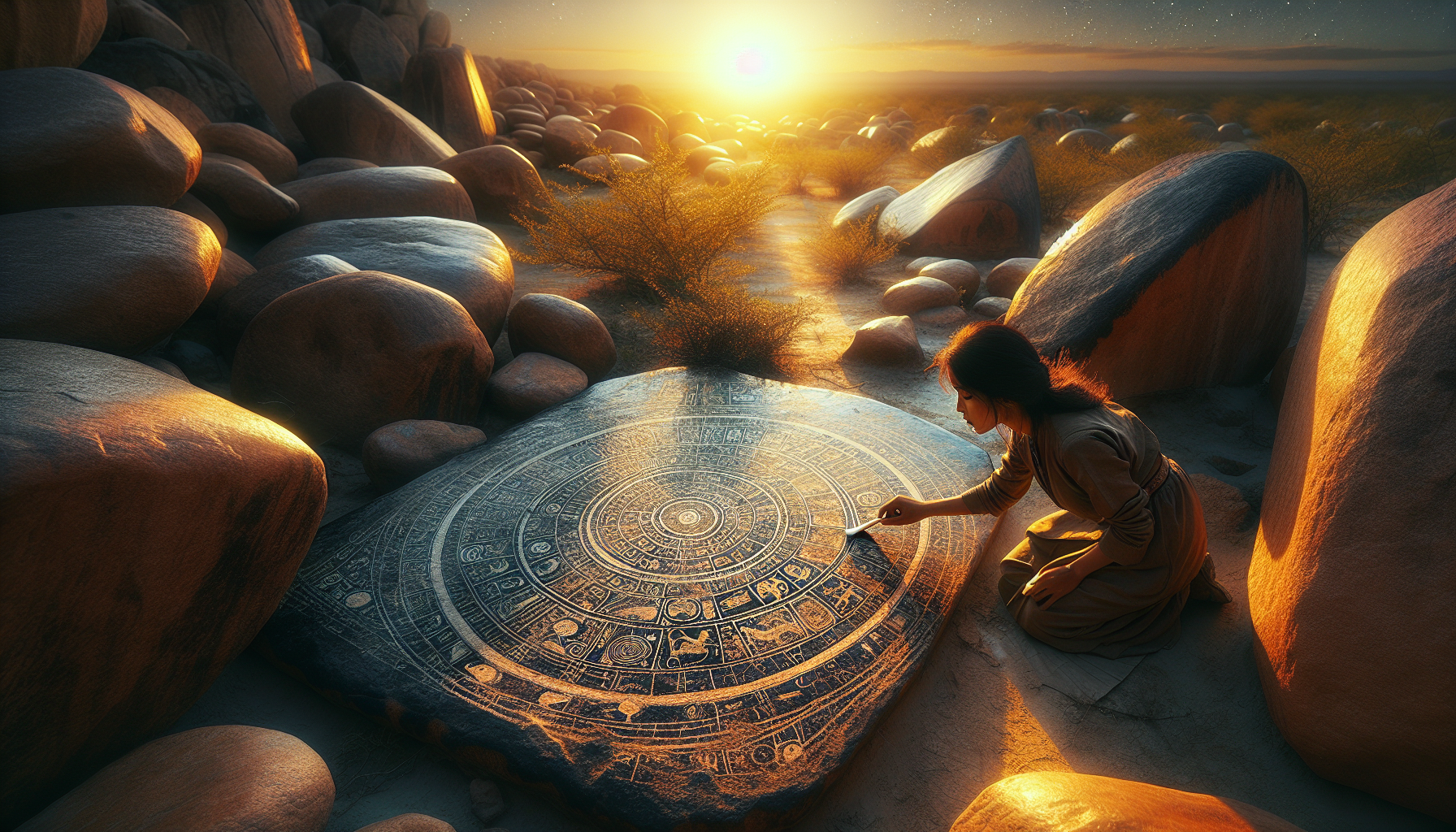In the vast tapestry of human history, there are threads that shimmer with the allure of the unknown, enticing us to unravel their secrets. Among these enigmatic threads are the ancient petroglyphs—carvings etched into stone by civilizations long past. These stone engravings, scattered across the globe, are more than mere artistic expressions; they are portals to understanding the worldviews of our ancestors. Imagine a time when the night sky was the ultimate canvas, inspiring awe and curiosity. It was a time when the celestial bodies were not just distant points of light but divine entities and guides. Our journey today will delve into the captivating world of petroglyphs and their intriguing connections to the stars, revealing the celestial secrets that our forebears immortalized in stone.
Petroglyphs are often found in remote, awe-inspiring landscapes, standing as silent sentinels of ancient wisdom. For centuries, they have puzzled historians, archaeologists, and enthusiasts alike, who strive to decipher their meanings and significance. But what if these carvings are more than mere symbols or storytelling tools? What if they represent sophisticated star maps or astronomical guides that speak to a deep understanding of the cosmos by ancient peoples? This article will take you on a journey through time, exploring how these fascinating stone etchings could be keys to unlocking the celestial knowledge of our ancestors.
From the sun-drenched deserts of the American Southwest to the rugged terrains of Scandinavia, petroglyphs have been discovered in diverse locations, each with unique stories and mysteries. Could it be that these ancient artists were capturing their observations of the night sky, preserving their celestial knowledge for future generations? As we delve into specific examples, we’ll explore how these ancient societies might have used petroglyphs to document solstices, equinoxes, and other astronomical phenomena, effectively creating a celestial calendar etched in stone.
Moreover, we will examine the techniques and tools used by these ancient stargazers. How did they achieve such precision without modern technology? What materials did they use, and what challenges did they face in carving these intricate designs? Through this exploration, we will gain insights into the ingenuity and resourcefulness of our ancestors, who sought to connect with the universe in ways that still resonate with us today.
Finally, we will contemplate the broader implications of these discoveries. In an age dominated by technology and rapid change, what can we learn from these ancient celestial maps? How do they inspire us to reconnect with the natural world and our own innate curiosity about the universe? As we conclude our exploration, we invite you to reflect on the timeless allure of the stars and the enduring legacy of those who first dared to etch their mysteries into the fabric of the earth. So, prepare to embark on a journey through time and space, as we unveil the ancient mysteries of star maps etched in stone. 🗿✨
The Significance of Petroglyphs in Ancient Cultures
Petroglyphs, the ancient rock carvings found in various parts of the world, serve as invaluable historical records that offer insights into the lives, beliefs, and celestial observations of ancient civilizations. These carvings, etched into stone surfaces, have withstood the test of time, providing modern researchers with clues about the past. The significance of these petroglyphs extends beyond mere artistic expression; they represent a complex interplay between ancient cultures and their understanding of the cosmos.
Many ancient cultures, from the Native Americans in North America to the Aboriginals in Australia, used petroglyphs as a medium to document their interactions with the natural world and the celestial bodies they observed. These carvings often depicted star maps, lunar phases, and celestial events, serving as both educational tools and ceremonial artifacts. By studying these petroglyphs, researchers can piece together how ancient peoples viewed their place in the universe and how they used celestial events to guide their agricultural, navigational, and spiritual practices.
The significance of petroglyphs lies not only in their historical and cultural value but also in their ability to foster a deeper understanding of how early civilizations interpreted the cosmos. This understanding is crucial for appreciating the intellectual achievements of our ancestors and acknowledging the continuity of human curiosity about the universe. As modern technology continues to advance, researchers can leverage these tools to enhance their study of petroglyphs, unraveling the celestial secrets hidden in these ancient carvings.
The Role of Star Maps in Ancient Navigation
Star maps, often represented in petroglyphs, played a critical role in ancient navigation. For civilizations that relied heavily on seafaring and long-distance travel, the stars provided a reliable guide across vast and featureless landscapes. Ancient mariners used the night sky as a celestial map, charting their courses by the positions of stars and constellations. These navigational star maps were not only crucial for trade and exploration but also for cultural exchange and the spread of ideas across continents.
One of the most fascinating aspects of star maps in ancient navigation is their accuracy and sophistication. Despite the lack of modern technology, ancient navigators developed intricate systems to track celestial bodies and predict their movements. This knowledge was often passed down through generations, encoded in petroglyphs, oral traditions, and practical training. The ability to navigate using the stars was not just a technical skill but also a reflection of a deep understanding of the cosmos and its rhythms.
Today, researchers continue to study ancient star maps etched in stone, seeking to unravel the techniques and knowledge that allowed early civilizations to navigate vast distances with precision. By comparing these ancient maps with modern astronomical data, scientists can gain insights into how ancient peoples perceived and interacted with the night sky, enriching our understanding of human history and the development of navigational sciences.
Unveiling Celestial Secrets through Modern Technology
The study of petroglyphs and star maps has been revolutionized by modern technology, allowing researchers to uncover details that were previously inaccessible. Advances in imaging techniques, such as 3D scanning and digital enhancement, have made it possible to study the intricacies of petroglyphs without damaging the original carvings. These technologies provide a non-invasive way to capture high-resolution images of petroglyphs, revealing subtle details that may hold the key to understanding their meanings.
Moreover, the integration of Geographic Information Systems (GIS) with archaeological data has opened new avenues for analyzing the spatial relationships between petroglyph sites and celestial events. By mapping the locations of petroglyphs in relation to astronomical phenomena, researchers can explore the possibility that these carvings were strategically placed to align with specific celestial occurrences. This approach not only enhances our understanding of ancient cultures’ astronomical knowledge but also helps preserve these sites for future generations.
With the aid of modern technology, researchers are making significant strides in deciphering the celestial secrets hidden in petroglyphs. This ongoing research continues to shed light on the sophisticated understanding of astronomy possessed by ancient civilizations and their enduring legacy in the field of star mapping. As technology continues to evolve, the potential for new discoveries in this fascinating area of study remains immense, offering exciting opportunities for future research and exploration.
Comparative Analysis of Petroglyphs Around the World
The study of petroglyphs offers a unique opportunity to compare the artistic and astronomical expressions of diverse cultures across the globe. Although these rock carvings are found in different regions, there are striking similarities in their themes and representations, suggesting a shared human fascination with the cosmos. By conducting a comparative analysis of petroglyphs from various cultures, researchers can identify commonalities and differences that provide insights into the universal aspects of human experience and the unique cultural contexts that shaped each civilization’s celestial interpretations.
| Region | Common Themes | Unique Characteristics |
|---|---|---|
| North America | Animals, celestial bodies, spirals | Specific tribal symbols and deities |
| Australia | Human figures, animals, celestial events | Emphasis on Dreamtime stories |
| Europe | Geometric shapes, animals, celestial patterns | Complex megalithic structures |
While the thematic elements of petroglyphs may overlap, each culture’s unique approach to depicting these themes provides valuable context for understanding their worldview. For instance, the incorporation of tribal symbols in North American petroglyphs reflects the deep connection between indigenous peoples and their spiritual beliefs. Similarly, the emphasis on Dreamtime stories in Australian petroglyphs underscores the importance of mythology and cosmology in Aboriginal culture.
Explore More: Watch This Video on Petroglyphs
For a deeper understanding of how petroglyphs have been used to map the stars and their significance across cultures, watch the informative video titled “Decoding the Celestial Maps in Ancient Petroglyphs” from the channel Ancient Origins. This video provides an engaging exploration of the topic and showcases some of the most fascinating petroglyph sites around the world.
- Petroglyphs serve as historical records and celestial guides.
- Star maps in petroglyphs reveal ancient navigational skills.
- Modern technology is unlocking petroglyphs’ celestial secrets.
- Comparative analysis highlights cultural diversity and shared human interests.

Conclusion
Conclusion: Unveiling Ancient Mysteries: Star Maps Etched in Stone
In exploring the captivating subject of star maps etched in stone, we journeyed through time and space to unlock the celestial secrets hidden within ancient petroglyphs. These enigmatic carvings, left by civilizations long past, serve not only as artistic expressions but also as sophisticated representations of the cosmos. Throughout this article, we examined the intricate relationship between early human societies and their celestial observations, demonstrating the profound impact that the stars had on their cultures, rituals, and understanding of the universe.
One of the key points discussed was the significance of petroglyphs as a form of communication across generations. These stone engravings were not merely decorative; they were deliberate, complex messages intended to convey astronomical knowledge. By studying the patterns and symbols within these petroglyphs, modern researchers have uncovered insights into how ancient peoples perceived celestial events and used this knowledge for navigation, agricultural planning, and spiritual guidance. The alignment of certain petroglyphs with astronomical phenomena, such as solstices and equinoxes, underscores their creators’ sophisticated understanding of the sky.
Furthermore, we delved into specific examples of sites where these celestial petroglyphs are prominently featured. From the Nazca Lines in Peru to the Chaco Canyon in the United States, these locations serve as living museums of human ingenuity and cosmological curiosity. Each site offers a unique glimpse into how different cultures across the world developed their star maps, reflecting diverse mythologies and cosmologies. By comparing these sites, we gain a deeper appreciation for the universality of humanity’s fascination with the stars.
The article also highlighted the role of modern technology in uncovering the mysteries of these ancient carvings. Techniques such as 3D imaging, drone photography, and digital mapping have allowed researchers to document and analyze petroglyphs with unprecedented precision. These advancements not only aid in preservation efforts but also enable scholars to piece together the puzzle of our ancestors’ celestial knowledge with greater clarity.
In reinforcing the importance of this topic, it’s crucial to acknowledge the broader implications of understanding ancient star maps. These petroglyphs are a testament to the shared human experience and our innate desire to connect with the cosmos. They remind us that, despite the vastness of time and space, we are all part of a continuum that stretches from the distant past into the future. Recognizing the ingenuity and wisdom of our ancestors can inspire us to foster a deeper connection with the world around us and to preserve these cultural treasures for future generations.
As we conclude this exploration of star maps etched in stone, I encourage you to reflect on the ways in which ancient knowledge can inform and enrich our modern lives. Whether through visiting archaeological sites, participating in cultural preservation initiatives, or simply gazing up at the night sky, there are countless ways to engage with this fascinating intersection of history and astronomy. 🌟
Your thoughts and insights are invaluable, so I invite you to share your comments below. What did you find most intriguing about the celestial secrets hidden in petroglyphs? How do you think this ancient wisdom can be applied today? By engaging in this dialogue, we can continue to unravel the mysteries of our shared heritage and foster a greater appreciation for the wonders of the universe.
Feel free to share this article with friends and colleagues who might be interested in the captivating world of ancient astronomy. Together, we can ensure that these celestial secrets are not only preserved but also celebrated for the remarkable achievements they represent.
For further reading on this topic, I recommend visiting reputable sources such as the Archaeological Institute of America and NASA’s Night Sky Network. These platforms offer a wealth of information on archaeology and astronomy, providing additional context and resources for those eager to dive deeper into the world of star maps and ancient carvings.
In the end, the journey to unveil these ancient mysteries is an ongoing adventure that invites us all to become explorers of the past and guardians of the celestial knowledge that connects us to our ancestors. 🌌
Toni Santos is a visual storyteller and cosmic interpreter whose work illuminates the ancient skywatchers and their prehistoric astronomy—the profound ways early humans observed and revered the heavens before written history. Through a visionary lens, Toni explores how the stars, planets, and celestial cycles shaped myth, ritual, and survival in cultures lost to time.
Rooted in a fascination with archaic observatories, stone alignments, and celestial symbolism, Toni’s creative journey reveals the deep human impulse to understand and harmonize with the cosmos. From lunar phases guiding planting seasons to the sacred paths of the Milky Way, each of his works embodies the awe and knowledge encoded in the night sky.
Combining artistic craftsmanship with archaeological insight, Toni’s pieces evoke the mystery and precision of prehistoric astronomers. His work does more than depict—it channels the timeless dance between earth and sky, bridging ancient wisdom with contemporary wonder.
As the visionary behind Vizovex, Toni shares curated visuals, essays, and symbolic studies that invite others to reconnect with the cosmic heritage written in stone and starlight. His creations are a call to look upward, to listen to the silent stories told by the stars, and to honor the first astronomers who mapped the heavens with reverence and ingenuity.
His work is a tribute to:
The celestial wisdom of prehistoric peoples
The sacred geometry of ancient observatories
The enduring bond between human culture and the cosmos
Whether you’re a stargazer, a scholar of ancient mysteries, or someone captivated by the universe’s earliest storytellers, Toni welcomes you to journey through a space where the sky is both map and myth—one constellation, one ritual, one revelation at a time.




